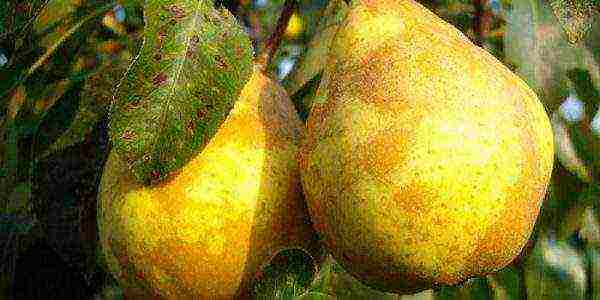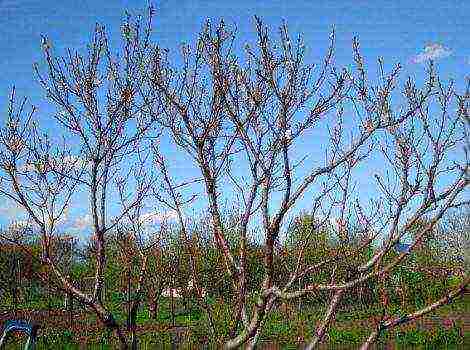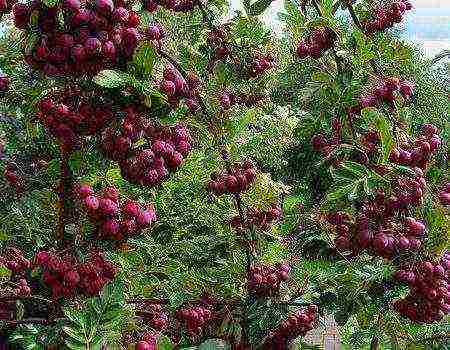Content [show]
Description of varieties of pear Williams
Today, many varieties of pear are known, but only some of them have existed for more than a hundred years, and, despite such a very venerable age, they are very popular and are actively cultivated. One of these varieties is Williams pear.
We will talk about the description of this variety in this article.
The history and origins of the Williams pear
Williams pear variety was obtained in southern England (Beckshire) around 1796 by Wheeler. It was created on the basis of the common pear species, but it is not known exactly which plants were used as parents, so the origin of the Williams pear is considered uncertain.
Interestingly, it was named after Robert Williams, who first showed it to an organization for the cultivation of various fruit and horticultural crops (London) in 1816 and spent a lot of effort to popularize it. The next country where this pear variety began to be intensively cultivated is France (1828). And a little later it appeared in other European countries.
Williams appeared in orchards in southern Russia around 1860 from a private Crimean nurserybelonging to the gardener N.P. Makukhin. This variety is called differently: Barlet, Summer Duchess, Summer Williams, Red and Williams Bon-Chretien.

Growing region of the summer variety
In 1947, the hybrid passed state variety trials, and was found suitable for cultivation (zoned) for the North Caucasus region (North Ossetia, Karachay-Cherkessia, Krasnodar Territory, Kabardino-Balkaria, Adygea, Stavropol Territory, Chechnya and Ingushetia).
It is also actively cultivated in the Rostov region. and in many former republics of the Soviet Union (Moldova, Georgia, Ukraine, Tajikistan, Kyrgyzstan, and so on).
Description and characteristics
The red pear is the benchmark among pears that ripen at the end of summer. It can be grown in large gardens of agricultural enterprises, in a personal plot and in a country house. Pear is one of the world's best dessert varieties that ripen in late summer (August).
The crown of the tree has the shape of a wide or rounded pyramid and is often asymmetrical. Young specimens grow quite quickly, but when the trees reach the age of 10-12 years, the growth rate decreases significantly. Also, one of the reasons for the slowdown in growth in the Williams variety is large yields and early onset of fruiting. Annual growth rates can range from moderate to low.
Straight or slightly deviated thick branches are covered with light yellowish bark with a small number of lentils. The main skeletal branches and trunk are gray.
Quite large leaves shaped like an egg, they have a smooth and shiny surface. Small denticles are located along the raised edges of the leaf blade. Light green veins protrude slightly above the surface.

Whitish-cream flowers are collected in inflorescences of 6-7 pieces. They begin to bloom before the leaves appear. Abundant flowering lasts a long time.
Fruits in inflorescences are mainly tied in 2 or 3 pieces and stick firmly to the branches. The weight of one pear is 170 grams, but on young specimens it can reach 180 grams.
Large or medium-sized fruits with a slightly bumpy surface are covered with a thin, fragrant skin, painted in a light greenish color (at the time of ripening). When fully ripe, it becomes a beautiful yellowish shade with gray dots. Sometimes a delicate pinkish spot appears on the side facing the sun. The fruits are attached to the shoots with slightly curved, thick stalks. The dark brown, smallish seeds are ovoid and have a sharp tip.
Juicy and tender pulp with an attractive dessert taste, nutmeg aroma and slight sourness, colored yellow-white.
The Williams variety can be used fresh, for the preparation of compotes, preserves, marinades, as well as for drying (universal).
The time for removable maturity begins in the second half of August. Fruits taken at this time last for about two weeks. Pears of this variety can be stored in the vegetable compartment of the refrigerator for about one and a half months.
Summer Williams, grafted on a pear, begins to bear fruit at the age of 5-6 years, if he is grafted on quince, then the first crop can be harvested already for 3-4 years. But it is worth remembering that such trees do not live long.
The yield directly depends on the growing conditions. For example, the average yield of a tree aged 12 to 18 years in the Krasnodar Territory is 100-200 centners per hectare, and in the Crimea - from 80 to 150 kg per tree.
This variety is self-fertile, and in order to obtain abundant yields, it is necessary to plant a number of pollinating varieties. The best pollinators for Williams pears are Alexandrovka, Lyubimitsa Klappa, Bere Bosc, Olivier de Serre.

Advantages and disadvantages of a red pear
This hybrid is attracting attention:
- early fruiting;
- constant large harvest;
- large beautiful fruits;
- undemanding to soil conditions.
The disadvantages include:
- poor winter hardiness;
- self-fertility and low level of drought resistance;
- severely affected by scab, copperhead and aphids.
You may also be interested in the following varieties of pears:
- Description of the pear variety Lada
- The most complete characteristic of the Veles pear variety
- Planting and caring for a pear in memory of Yakovlev
- Pear planting rules Forest beauty
Seedling selection rules
For planting, it is best to choose 1-2 year old seedlings with a height of 1.3 to 1.5 meters. In trees of this age, the distance from the root collar to the lateral shoots is more than 50 cm, and the number of branches varies from 3 to 5 pieces.
The length of the roots of seedlings of this age is 20-30 cm. Also, there should be no mechanical damage on a young pear., root shoots and leaves (green or dry). The central shoot must also be well formed.

Landing
For growing Williams pears, a sunny area with nutritious permeable soil is selected.
The best time to plant is in the fall (when the growing season ends), but you can do this in the spring (before bud break).
A hole for planting is dug 60 by 60 by 80 cm in size.To backfill the roots, it is advisable to prepare an earthen mixture consisting of humus (one part), garden soil (one part), superphosphate (350 gr.), Potassium sulfate (350 gr.).
Before planting, the root system of the pear is inspected, broken and dried, and then soaked in a solution of heteroauxin (or any other root formation stimulant) for 3-12 hours.
In the planting pit, the roots are distributed evenly, covered first with garden soil, and then with a mixture.This is done so that the roots do not come into contact with the fertilizer mixture. At the same time, be sure to make sure that the space between them is filled. After planting, the seedling is well watered, the soil is slightly compacted and the sagging earth is poured.
Care
All tree care consists of watering, fertilizing, pruning, pest and disease control.

Watering
Young pears in the first 2-3 years after planting need regular watering throughout the season. It is advisable to cover the ground around the trunks with a layer of mulching material (peat, buckwheat or pine nut husks, wood chips) with a height of 5 to 8 cm.This retains moisture in the ground, prevents a large number of weeds from growing and reduces the amount of watering. In addition, mulching prevents the formation of a dense crust on the surface of the soil.
Mature trees are watered 3 to 7 times per season, depending on climatic conditions and weather. But watering must be done before blooming flowers, after flowering and in autumn, when the season ends.
Top dressing
Young trees need to be fed every spring before they begin to bear fruit. To do this, the land around the trees is mulched with rotted manure in a layer of 4 to 6 cm. It is also advisable to add 100-150 grams (for each tree) to Kemir or Azofoska.
Feeding adult pears is best done in the fall.when digging is carried out. For this, mullein or other types of organic fertilizers are used in combination with mineral fertilizers (superphosphate and potassium sulfate). Fertilizers are scattered around the trunk circle, which corresponds to the diameter of the crown and must be dug to a depth of 25 to 35 cm so that the nutrients reach the root system.
If the harvest is not expected to be very large, then additional fertilizing can be carried out before shedding the ovary.
Pruning
It is advisable to prune young pears after planting in early spring. From 3 to 5 lateral branches are left on the tree, which should be located at a height of 50 to 70 cm above the ground. The central trunk is cut so that it is 15-30 cm higher than the highest lateral shoot. The length of the lateral shoots must be reduced to 30 cm.
Pruning of mature trees is carried out twice a year. Sanitary pruning is done to regularly remove diseased, broken and shriveled branches. Also, rejuvenating pruning is carried out, with the help of which the intensive growth of the plant is maintained and restored, as well as the number of fruiting points is regulated.
During rejuvenating pruning, perennial shoots are shortened to 3-5-year-old and older branches. If the growth of annual shoots has decreased to 15-20 cm, then weak pruning is carried out (for 2-3-year-old branches), and if the growth is even less, then pruning is increased. For thinning, part of the old fruitful branches inside the crown is cut out.

Diseases and pests
Among the diseases that can affect this pear variety, it is worth highlighting the following diseases: cytosporosis, fruit rot, scab, rust and root cancer.
Cytosporosis occurs on the bark of the trunk and skeletal branches in the form of a slightly depressed spot, painted in a brownish-reddish tint. Cracks appear along the edge of the spot over time, and the tissues of the bark soften.
At the beginning of the disease, the diseased areas are cleaned and treated with copper sulfate, and then with garden varnish.
Rust appears on the upper surface of the leaves as orange round spots. In July, on the lower part of diseased leaves, growths are formed in the form of swellings, where rust spores are formed.
To combat this disease, spraying with the following drugs is carried out: Bordeaux liquid (4% solution), colloidal sulfur (2% solution). Treatments are carried out before flowering, after flowering and after two weeks.
The scab first appears on the leaves as green-black spots that grow rapidly. Then the leaves dry out prematurely and fall off. In addition, the scab infects fruits and young shoots. Dense leathery spots form on the fruits, and the flesh under them cracks heavily. The bark of diseased shoots is covered with cracks, they bend and dry out.

Prevention of this disease is regular cleaning and destruction of diseased fruits and fallen leaves.
When scab appears, the trees are sprayed three times (before and after flowering, and also after two weeks). For this, Bordeaux liquid and colloidal sulfur are used.
Control methods
Among the pests that attack a pear, it is worth noting aphids, pear leaf beetle (honeydew), pear gall mite, pear bug, Californian scale insect, green apple aphid.
The larvae of the green apple aphid feed on the juices of young leaves from the buds, and later on young shoots. Damaged leaves curl, dry out and fall off... Young shoots stop growing and dry up.
Great harm to the pear is caused by the larvae of the pear leaf beetle, which feed on the cell sap of leaves, buds, buds and young shoots. As a result, the flies cause massive loss of leaves, ovaries and flowers, as well as underdevelopment of fruits and curvature of shoots.
When this pest appears, several sprays are carried out (during the swelling of the buds, in summer and autumn). To do this, use means such as Iskra, Inta-Vir, Aktara and Commander.
Gardeners reviews
Oksana, Zaporozhye: We have two trees of this variety growing for the 6th year. Low, spreading trees. The harvests are simply amazing. All branches are simply stuck with fruits, props were made for each branch, otherwise they would not have survived. Such an abundance of fruits delights not only us, but also our neighbors and everyone who comes to visit. Very tasty pear, juicy, sweet. Very pleased.
Makar, Crimea: Summer Williams in Crimea is also called Dunka, very sweet and cool, and fragrant. And unlike Clapp's Favorite, it doesn't spoil quickly, in the middle. Here Klappa really becomes "mushy" when overripe, and brown in the middle. So you need to consume greenish, do not wait for yellowing.
Not a single person will refuse the Williams variety, and therefore, despite some of the shortcomings of this variety, it should be grown in their dachas and personal plots.


